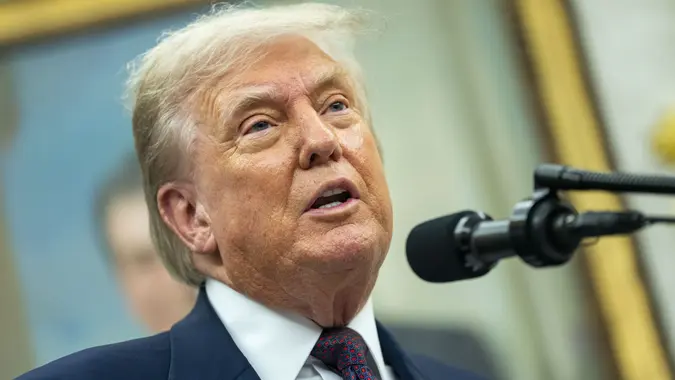Grant Cardone Calls Trump’s Income Tax Plan for Middle Class ‘Brilliant’: 2 Reasons He’s Right (And 5 He’s Wrong)

Commitment to Our Readers
GOBankingRates' editorial team is committed to bringing you unbiased reviews and information. We use data-driven methodologies to evaluate financial products and services - our reviews and ratings are not influenced by advertisers. You can read more about our editorial guidelines and our products and services review methodology.

20 Years
Helping You Live Richer

Reviewed
by Experts

Trusted by
Millions of Readers
One of President Donald Trump’s tax policy goals is to eliminate federal income taxes for individuals earning under $150,000 per year. Real estate investor and motivational speaker Grant Cardone applauded the plan, calling it “brilliant” and a potential game-changer for the middle class in a post on X.
There’s no formal policy yet, but the proposal could save middle-income households an estimated $38,000 per year, according to Cardone. But is it really that simple?
While Cardone and others see this as a big win, critics warn it could come with hidden costs and long-term trade-offs.
Why Cardone Might Be Right
Trump’s tax plan could empower the middle class and stimulate economic growth. Here’s what could happen if the plan goes into effect.
More Money in People’s Pockets
“By eliminating income taxes for those earning under $150,000, families could see a meaningful boost in disposable income, allowing them to save, spend and invest more strategically,” said George Carrillo, co-founder and CEO of the Hispanic Construction Council (HCC).
This could also push many families into a comfortable range for affording homes, Carrillo added, especially when paired with reduced federal tax burdens.
“Cardone’s emphasis on homeownership resonates here, as families saving thousands on taxes could finally amass the resources needed for down payments and monthly mortgage payments, stimulating demand for housing and bolstering industries tied to construction and real estate,” he explained.
Potential Economic Boost
Given that 93% of Americans aged 15 and over earn less than $150,000, according to the 2022 U.S. Census, the plan could significantly boost disposable income and stimulate the economy, explained Tasha Preisner, managing partner at DeMar Consulting Group.
“Since most people love to spend money rather than save it, this would also start to stimulate the economy by driving up the demand for goods and services,” Presiner said.
She pointed to Tax Foundation data indicating that households would save 14.5% of their yearly income, on average.
Why Cardone Might Be Wrong
While the plan sounds appealing on the surface, critics argue it may create more problems than it solves.
Higher National Debt
“Sounds like a great idea, and one that would likely be very popular with Trump’s political base, but the math simply doesn’t add up,” according to Robert R. Johnson, Ph.D., CFA, CAIA, professor of finance at Heider College of Business at Creighton University.
Johnson warned that eliminating income taxes for those under $150,000, along with extending the Trump tax cuts — including no taxes on Social Security, overtime or tips — would balloon the budget deficit and cause the national debt to soar.
“Running the federal government requires the math equation of receipts versus expenditures to make sense,” Johnson explained. “The current problem is that receipts are much lower than expenditures, and eliminating these taxes would exacerbate the difference. And, collecting tariffs on imported goods would not make up the difference from these proposed tax cuts.”
Rising Costs
Taxpayers could also see a rise in the cost of living.
“The benefits of the tax plan could be undercut by reliance on tariffs to replace federal revenue, potentially causing inflation that drives up costs for everyday goods, services and even construction materials,” Carrillo said.
Overly Ambitious
The $38,000 in tax savings that Cardone claims may be unrealistic for the average taxpayer.
“Cardone’s estimate of $38,000 annual savings per household also appears overly ambitious, since middle-class taxpayers typically owe significantly less in federal taxes, often $10,000 to $15,000,” Carrillo explained.
Program Funding Shortfalls
A sharp reduction in tax revenue could create a significant budget shortfall, placing even greater strain on already-underfunded social programs, infrastructure and national defense.
Preisner claimed that Social Security and Medicare would most likely take the hardest hits due to the funding challenges.
“This would cause severe suffering of our elderly that have no other options in our society besides reliance on these programs for their very survival and who worked their whole lives to earn these benefits,” Preisner added.
Disincentive To Earn More
Setting a hard cutoff at $150,000 could unintentionally discourage people from pursuing raises, promotions or taking on extra work.
“This means that those taxpayers that are right above the $150,000 threshold would likely change their earning habits to drop into the 0% tax bracket, causing an even higher tax deficit than what we are seeing with the historical numbers,” Preisner explained. “This would cause an extra tax revenue deficit over the next decade as families aim to only make enough money ‘on paper’ to get away with not having to pay any taxes at all.”
Editor’s note on political coverage: GOBankingRates is nonpartisan and strives to cover all aspects of the economy objectively and present balanced reports on politically focused finance stories. You can find more coverage of this topic on GOBankingRates.com.
 Written by
Written by  Edited by
Edited by 























